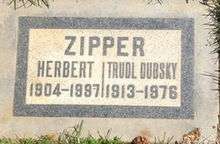Trudl Dubsky
Trudl Dubsky Zipper (31 January 1913 – 3 July 1976), born Gertruda Dubsky, was an Austrian-American innovative dancer, choreographer and teacher.
Trudl Dubsky | |
|---|---|
| Born | Gertruda Rosa Josefine Dubsky 31 January 1913 Vienna |
| Died | 3 July 1976 Los Angeles |
| Occupation | Dancer, dance educator, visual artist |
| Spouse(s) | Herbert Zipper (married 1939) |
Early life and education
Gertruda Rosa Josefine Dubsky was born in Vienna, the daughter of Wilhelm Josef Dubsky and Maria Theresia Dubsky. She trained and performed with the Bodenwieser School and was renowned for her dynamic modern dancing and high leaps.
Career
In 1932, with fellow Bodenwieser student Jeanette Rutherston, Dubsky co-founded the Rutherston-Dubsky School in London. She moved to the Philippines in 1937, to dance and teach. She founded the Manila Ballet Moderne during her time there.[1][2]
Dubsky was also an accomplished visual artist and her paintings of Manila during the Japanese occupation were published in Life magazine. Her husband later published a book of her watercolor paintings, Manila 1944-1945 As Trudl Saw It (1994), about those wartime experiences.[3] They left the Philippines in 1946,[4] but her husband returned several summers to conduct the Manila Symphony Orchestra; in 1967 both Zippers were honored for their contributions to the arts in Manila.[5]

Dubsky continued as a teacher and choreographer throughout her life, including at her studio in Brooklyn,[6] at Erwin Piscator's theatre workshop in New York, at the Chicago Conservatory of Music, with the North Shore Dance Group,[7] and later at the University of California, Los Angeles.[1]
Personal life and legacy
Dubsky married the Viennese pianist and composer Herbert Zipper,[8] in the Philippines in 1939.[9] She died from lung cancer in Los Angeles in 1976, aged 63 years.[4] The Dance Institute at the Colburn School was renamed the Trudl Zipper Dance Institute in 2008, after a large anonymous donation in her memory.[10][11] The Herbert Zipper Archives at Crossroads School in Santa Monica, California contain the couple's papers.[12][13]
References
- Vernon-Warren, Bettina; Warren, Charles (2013-12-19). Gertrud Bodenwieser and Vienna's Contribution to Ausdruckstanz. Routledge. pp. 92–93. ISBN 978-1-134-42366-8.
- Beltran Lucila, Ida. "Choreographers in Philippine Dance" National Commission for Culture and the Arts, Republic of the Philippines.
- Zipper, Trudl Dubsky; Zipper, Herbert (1994). Manila 1944-45 as Trudl saw it: watercolors of Trudl Dubsky Zipper. Crossroads School in cooperation with Herbert Zipper.
- Alcazaren, Paulo. "Loving the Zippers". philstar.com. Retrieved 2020-04-15.
- "Winnetka Couple Honored in Manila". Chicago Tribune. 1967-07-30. p. 313. Retrieved 2020-04-15 – via Newspapers.com.
- Davis, Ruth G. (1948-12-31). "Contemporary Comment; Dancing Pupils Expressing Themselves". The Brooklyn Daily Eagle. p. 9. Retrieved 2020-04-15 – via Newspapers.com.
- "North Shore Dance Group Sets Recital". Chicago Tribune. 1959-05-10. p. 107. Retrieved 2020-04-15 – via Newspapers.com.
- Smith, Dinitia (1997-04-23). "Herbert Zipper, 92, Founder Of Secret Orchestra at Dachau". The New York Times. ISSN 0362-4331. Retrieved 2020-04-15.
- Ephraim, Frank (2003-08-12). Escape to Manila: From Nazi Tyranny to Japanese Terror. University of Illinois Press. p. 56. ISBN 978-0-252-02845-8.
- "Colburn Dance Institute gets $9-million donation". Los Angeles Times. 2008-06-21. Retrieved 2020-04-15.
- "Performing-Arts School Receives Anonymous $9-Million". The Chronicle of Philanthropy. 2008-06-24. Retrieved 2020-04-15.
- "Students Extend Crossroads Dance Legacy". Crossroads School. 2016-11-09. Retrieved 2020-04-15.
- Groves, Martha (2007-04-21). "A Ghastly Past, an Exalted Life". The Los Angeles Times. p. 54. Retrieved 2020-04-15.
External links
- Trudl Dubsky at Find a Grave
- Trudl Dubsky's bookplate, designed before 1937 by Arthur Paunzen; at MutualArt.